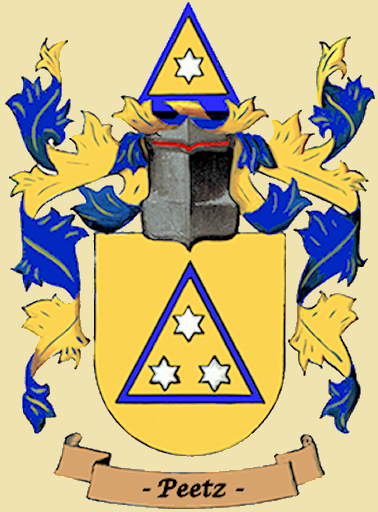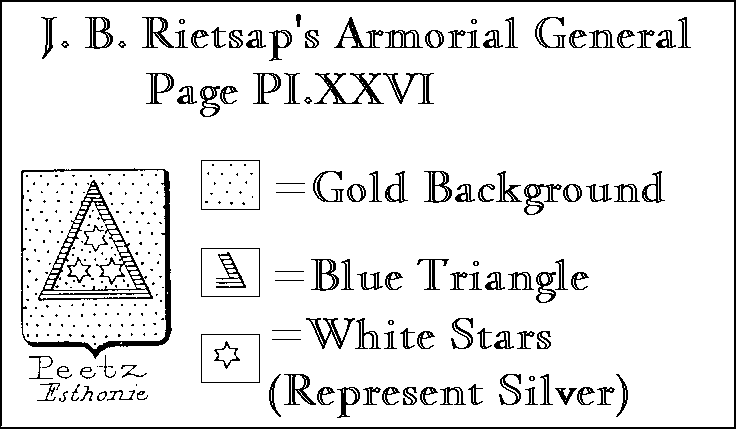 Heraldry began in Europe around the year 1150 at the time of the Holy Crusades when it became expedient for the land owners, who led their men to war, to be identified in battle.
Heraldry began in Europe around the year 1150 at the time of the Holy Crusades when it became expedient for the land owners, who led their men to war, to be identified in battle.
These arms have been drawn and painted by hand and are shown in traditional style with the helmet displayed above the shield to show the rank of the bearer. The arms are painted in a German style with the helmet being that of a German Ritter.
For hundreds of years it has been traditional to surround the helmet with mantling. The mantle originated at the time of the crusades; the Crusaders copying the Saracens in wearing flowing robes which they found not only protected them from the heat of the sun but easily entangled with the weapons of their enemies. However they preferred to use the colours of their own livery as opposed to the black of the Saracens. The lines in the mantle represent sword slashes.
 The arms associated with the Peetz name are taken from Rietstap’s Armorial Gèneral (P1.XXV) which reads:
The arms associated with the Peetz name are taken from Rietstap’s Armorial Gèneral (P1.XXV) which reads:
‘Peetz— Esthonie. D’or un triangle vidd’ d’azur, et trois étoiles mal— ordonndes d’argent., posses dans le triangle. Cimier— le triangle renfermant une dtoile d’argent et some’ d’une toile pareille. Lambrequins— d’or et d’azur.’ (translation: Estonia. Of now, to an emptied triangle of blue, and three poorly ordered stars of money, put in the triangle. Crest— the triangle containing a dtoile of money and some' of a similar canvas. Mantling of gold and of blue.
Gold - yellow in heraldry - is thought by some to have represented the first gift given to Christ at his birth and that silver - white in heraldry - was a sign of purity. The true symbolic meaning of the triangle has most probably been lost in the mists of time but it was obviously very important to the bearer. A mullet represented a spur rowel and the bearer was demonstrating that he was a good horseman. Three may have been placed on the shield to represent the Holy Trinity. I believe the original arms are old and could date from the 12th or 13th century.
I do hope you obtain great pleasure from these arms.
D J Tassell
23rd January, 1996
Heraldic Arts
142 St. Johns Road
Golchester, Essex, United Kingdom
(Ancestry.com says that Peetz is possibly a habitational name from Peetz in Brandenberg or Peetzig in Pomerania (Poland); however Peetzig is not listed in the Armorial General. Peetz also may have originated in the Baltic Region of northeast Germany.).
Introduction to Heraldry
Heraldry can be defined as a communication system that uses colors and symbols for the purpose of personal or organizational identification. All forms of communication are solutions created to help solve problems - in heraldry’s case, the problem was one of limited visibility. Advances in armor in the 11th and 12th Centuries provided soldiers with increased protection, including helmets that covered much of a person’s face. Without being able to see one another well enough to tell friend from foe, allies and enemies alike agreed that a system of identification was necessary in order to be effective in combat. The shield, heraldry’s most recognizable component, provided a broad, flat surface on which to paint colors and symbols assigned to a particular nobleman and his knights. Often, a nobleman also attached a cloak embroidered with his personal colors and symbols to his armor before riding into battle—a custom that gave rise to the term “a coat of arms.”
By the time businessmen and landowners in Britain’s American colonies declared independence from the Crown in 1776, heraldry was found in every aspect of European life. Religious communities, trade guilds, city councils, and households all made use of heraldry, including the practice of passing down coats of arms from one generation to the next in families. Determined to sever ties with the excesses of monarchy and the nobility, the founding fathers of the United States made sure that the honors, titles, and privileges given to Europe’s elite had no place in their young republic. Consequently, the construction of early U.S. society included a rejection of traditional heraldry.
For over a century, the U.S. Government and its armed forces would forge ahead in shaping a new nation without any real centralized authority to register, record, or regulate the design and use of federal and military symbols (called “insignia”). Eventually, President Woodrow Wilson would share his concern about the wide range of colors, shapes, and sizes that comprised U.S. military insignia in the early part of the 20th Century. In 1918, the President directed the War Department to establish an office that could organize military insignia such as metal badges, ribbons, patches, and flags. The U.S. Institute of Heraldry traces its roots back to President Wilson’s order, a task that captures the very foundation of heraldry—namely, developing a system for clear communication and identification on the battlefield.
Today, The Institute of Heraldry continues its mission to provide the highest quality heraldic services to the Federal Government, the Armed Forces, and the Office of the President. As important for the modern soldier’s success as it was for that of the medieval knight, heraldry refuses to be just another relic of feudal or imperial times of old. Heraldry is alive and well, still helping to solve the timeless problem of making identification as effective as possible.